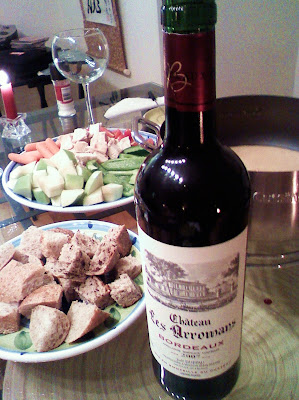 "Where did it go?" - Emmett
"Where did it go?" - EmmettThis bottle had been sitting on my shelf since July. Over the summer, I started going to wine tasting at Zola downtown after work. They'd usually sample 5 or 6 wines and there was always an incredible spread of complimentary cheese and crackers. We're talking smoked gouda, goat cheese, various hard cheeses - it was awesome and often a makeshift dinner. When I tried this red, I was enraptured. It was one of the weirdest tasting experiences I'd ever had. Over the past few months, I'd started to wonder if my tastebuds had imagined the whole thing. Finally, after finishing Fall finals, I decided to open it up and revisit my curiosity.
100% Temparanillo from Ribera del Duero, Spain, it was aged for 6 months in American, French, and Hungarian Oak. As you know by now, different oaks create different qualities in wine. I've never seen something aged in Hungarian oak, so I did a little research. Though regarded as similar, when compared with French oak, Hungarian oak adds "more nutmeg, clove, and sweet oriental spice." Maybe you haven't heard much about Hungarian oak; that's because for about half of the 20th century, the forests and industry were state-run and most of the oak barrels that were made went to European winemakers. It seems like you'll be seeing more of Hungarian oak, though, because the forests are full of trees, so to speak. As the result of massive chopping by the British a few hundred years ago (for shipbuilding during war), Hungary enacted laws requiring sustainable forest management - which, I guess, means they have to plant more than they chop. Coupled with recently increasing privatization of forest ownership, the Hungarian cooperage (barrel-making) industry is redeveloping and expanding to North American markets.
So, the funny thing about this wine is the finish. It just ... disappears. It starts out smelling a little fruity and rich. Medium-bodied and relatively mild tasting, the Roble is a little softer than most Temperanillos I've tasted. But just as the wine settles on your tongue and you start to grasp the flavors, it's gone. So weird. There is just a touch of tannin left, so you know you didn't dream the last 3 seconds, but everything else is gone. So you have to take another sip and try again. Repeat. Repeat. Repeat. To me, this was a pretty neat thing, and it made the wine light, fun, and easy to drink. But I'm not sure this lack of finish is technically a good thing in the wine world. I guess it depends what you're looking for, but as a precursor to a night out dancing, I liked that I didn't get bogged down in the details of this red.












 After a morning sampling most of the public bathrooms in Greenpoint, we finally made it over the bridge and dropped Meg of with her boyfriend's family for lunch. The three of us remaining (Han, Mon, and I) ended up in a little shop called Village Tart in Little Italy, in an effort to escape the heat of the city. After mulling over the wine list for a few, we hesitantly eyed a humble (relative to others) Riesling, but decided to talk to the server in hopes it was a dryer one. He assured us it was just a tad sweet, and despite his shiny gold t-shirt, we believed him.
After a morning sampling most of the public bathrooms in Greenpoint, we finally made it over the bridge and dropped Meg of with her boyfriend's family for lunch. The three of us remaining (Han, Mon, and I) ended up in a little shop called Village Tart in Little Italy, in an effort to escape the heat of the city. After mulling over the wine list for a few, we hesitantly eyed a humble (relative to others) Riesling, but decided to talk to the server in hopes it was a dryer one. He assured us it was just a tad sweet, and despite his shiny gold t-shirt, we believed him. 











